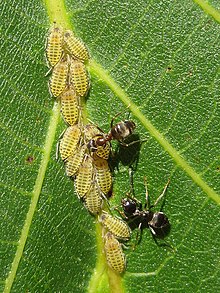
Back Мирмекофилия Bulgarian Mirmecofília Catalan Symbiotické vztahy mravenců Czech Myrmekophilie German Mirmecófilo Spanish Mürmekofiilia Estonian مورچهدوستی Persian Myrmécophilie French Mirmecofilia Galician Mirmecofilia Italian

Myrmecophily (/mɜːrməˈkɒfəli/ mur-mə-KOF-ə-lee, lit. 'love of ants') is the term applied to positive interspecies associations between ants and a variety of other organisms, such as plants, other arthropods, and fungi. Myrmecophily refers to mutualistic associations with ants, though in its more general use, the term may also refer to commensal or even parasitic interactions.
The term "myrmecophile" is used mainly for animals that associate with ants. An estimated 10,000 species of ants (Formicidae) are known, with a higher diversity in the tropics.[1] In most terrestrial ecosystems, ants are ecologically and numerically dominant, being the main invertebrate predators. As a result, ants play a key role in controlling arthropod richness, abundance, and community structure.[2] Some evidence shows that the evolution of myrmecophilous interactions has contributed to the abundance and ecological success of ants,[1][3] by ensuring a dependable and energy-rich food supply, thus providing a competitive advantage for ants over other invertebrate predators.[4] Most myrmecophilous associations are opportunistic, unspecialized, and facultative (meaning both species are capable of surviving without the interaction), though obligate mutualisms (those in which one or both species are dependent on the interaction for survival) have also been observed for many species.[5]
As ant nests grow, they are more likely to house more and greater varieties of myrmecophiles. This is partly because larger colonies have greater specializations, so more diversity of ecology within the nests, allowing for more diversity and population sizes among the myrmecophiles.[6][7]
- ^ a b B. Holldobler and E.O. Wilson, The Ants, Cambridge, Massachusetts: The Belknap Press of Harvard University Press, 1990.
- ^ K. Fiedler, B. Holldobler, and P. Seufert, "Butterflies and ants: The communicative domain," Cellular and molecular life sciences, vol. 52, 1996, pp. 14-24.
- ^ B. Holldobler and E.O. Wilson, Journey to the Ants, Cambridge, Massachusetts: The Belknap Press of Harvard University Press, 1994.
- ^ N. Bluthgen, N.E. Stork, and K. Fiedler, "Bottom-up control and co-occurrence in complex communities: honeydew and nectar determine a rainforest ant mosaic," Oikos, vol. 106, 2004, pp. 344-358.
- ^ B. Stadler and T. Dixon, Mutualism: Ants and their insect partners, Cambridge: Cambridge University Press, 2008.
- ^ KISTNER, DAVID H. (1979), "Social and Evolutionary Significance of Social Insect Symbionts", Social Insects, Elsevier, pp. 339–413, doi:10.1016/b978-0-12-342201-9.50015-x, ISBN 978-0-12-342201-9
- ^ Wilson, Edward O. (1971). The insect societies. Cambridge, Mass.: Belknap Press of Harvard University Press. ISBN 0-674-45490-1. OCLC 199513.